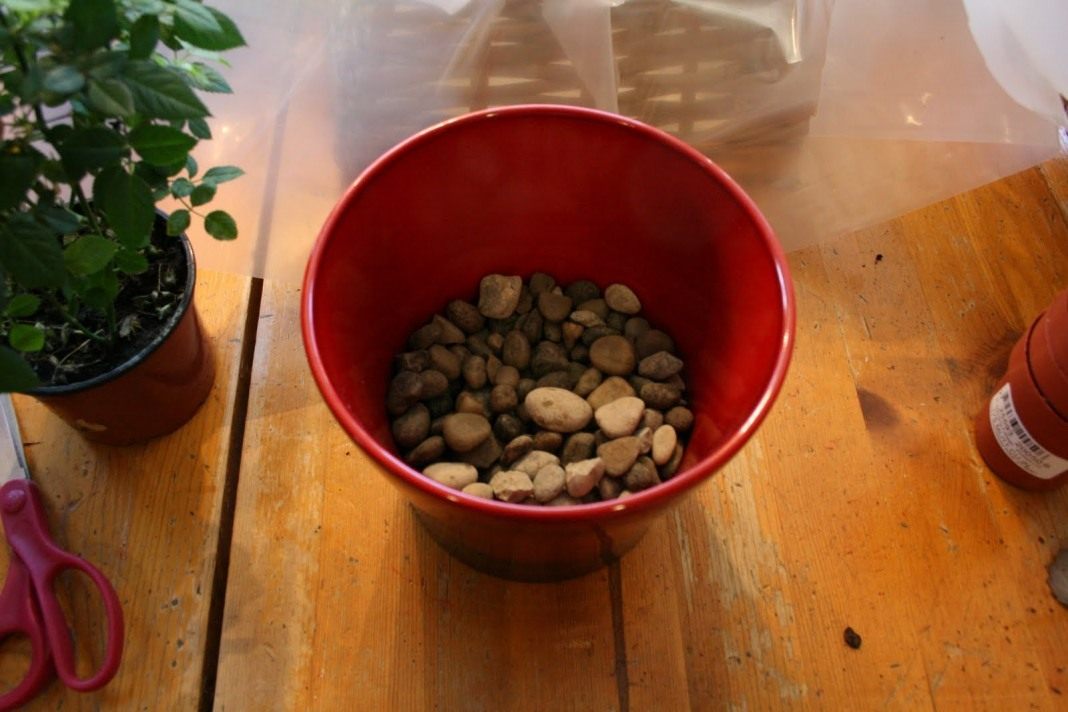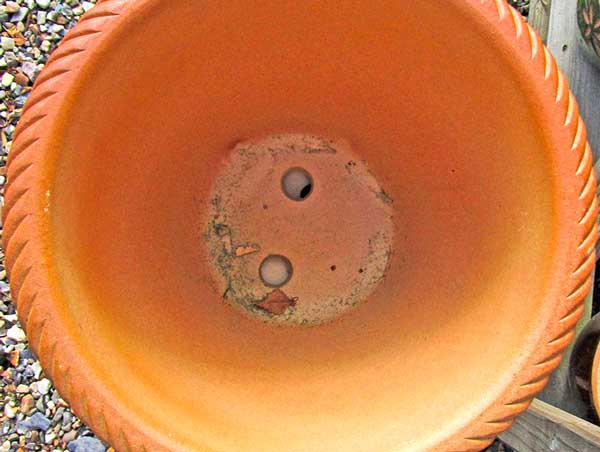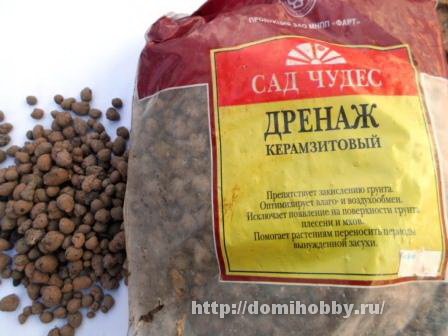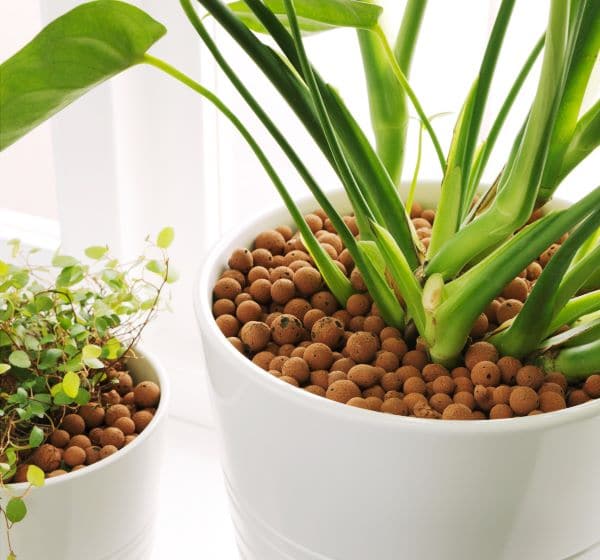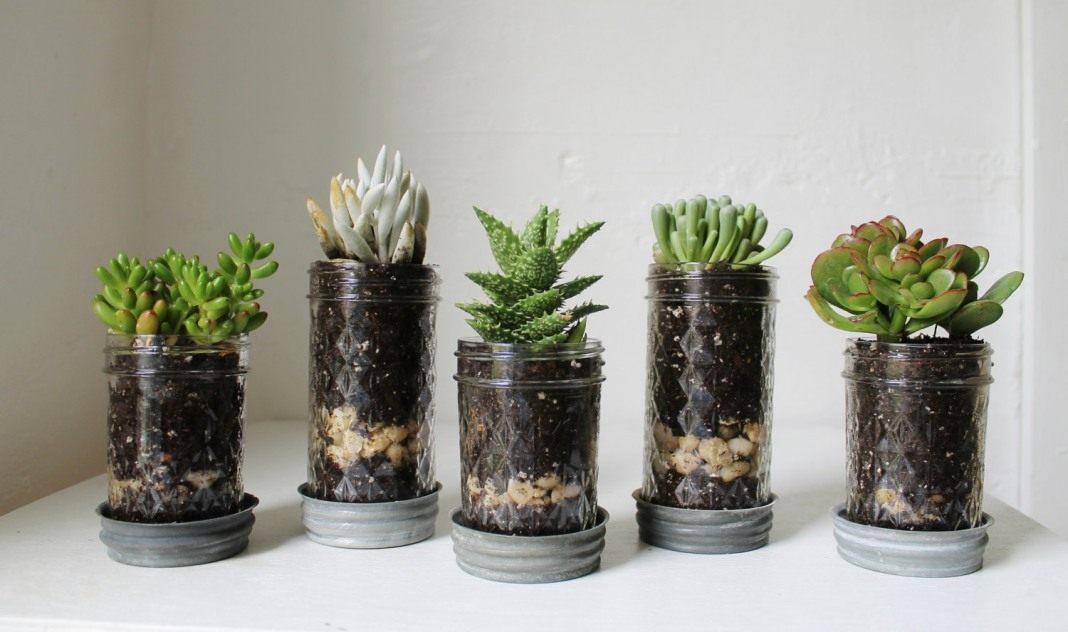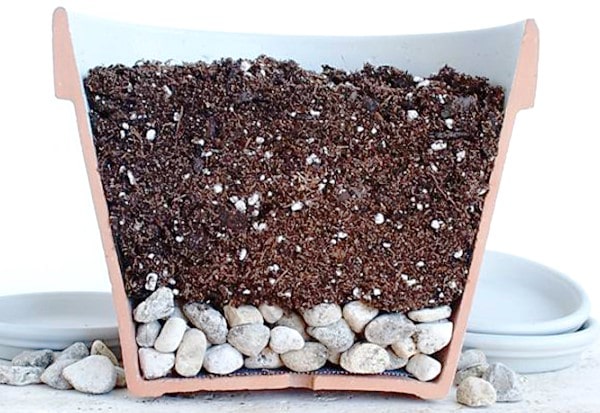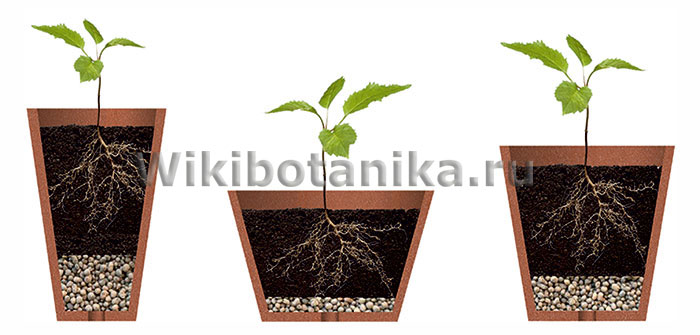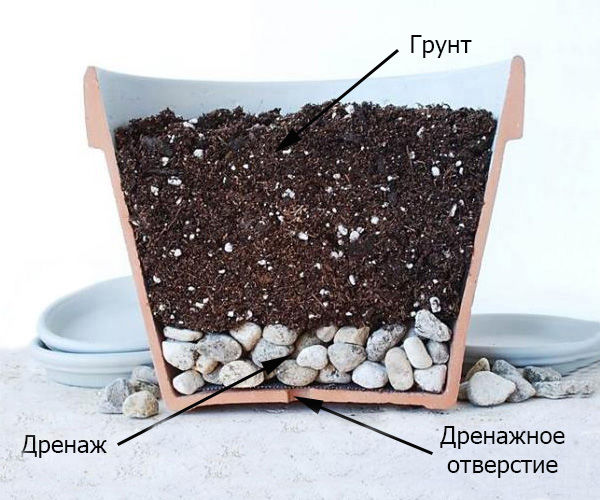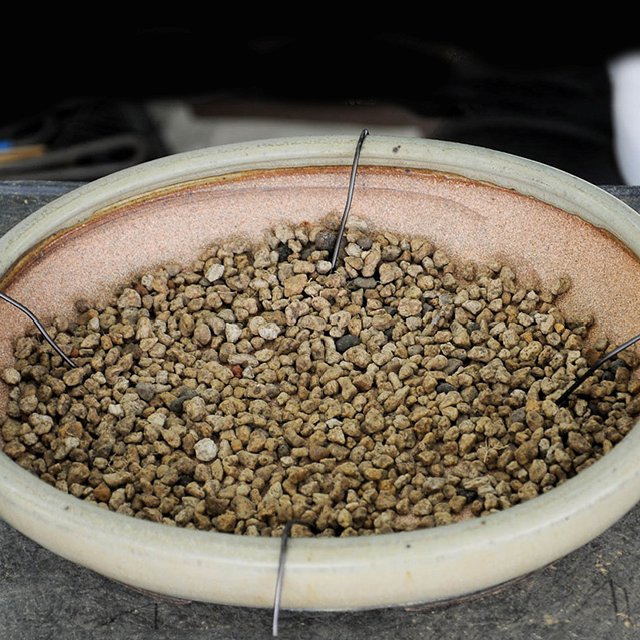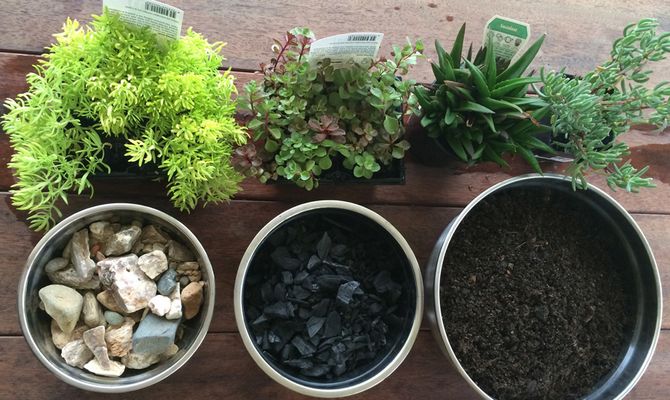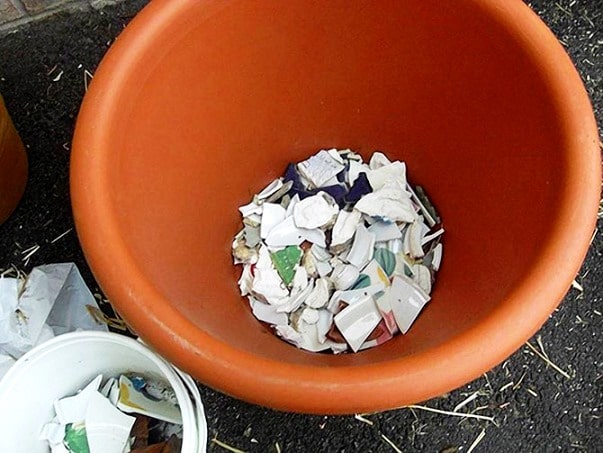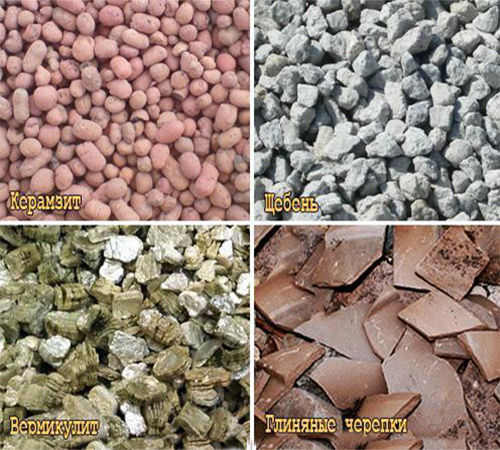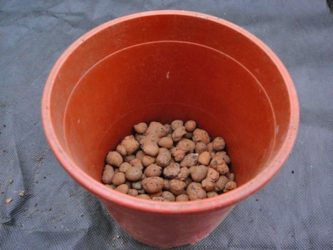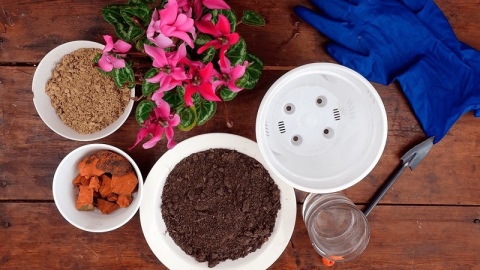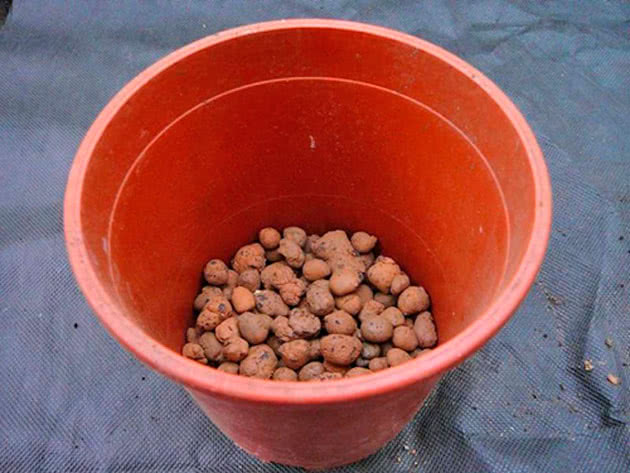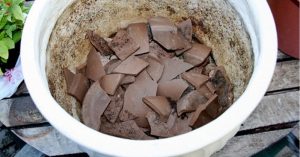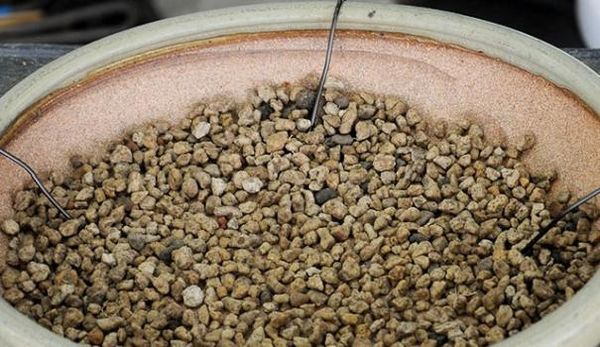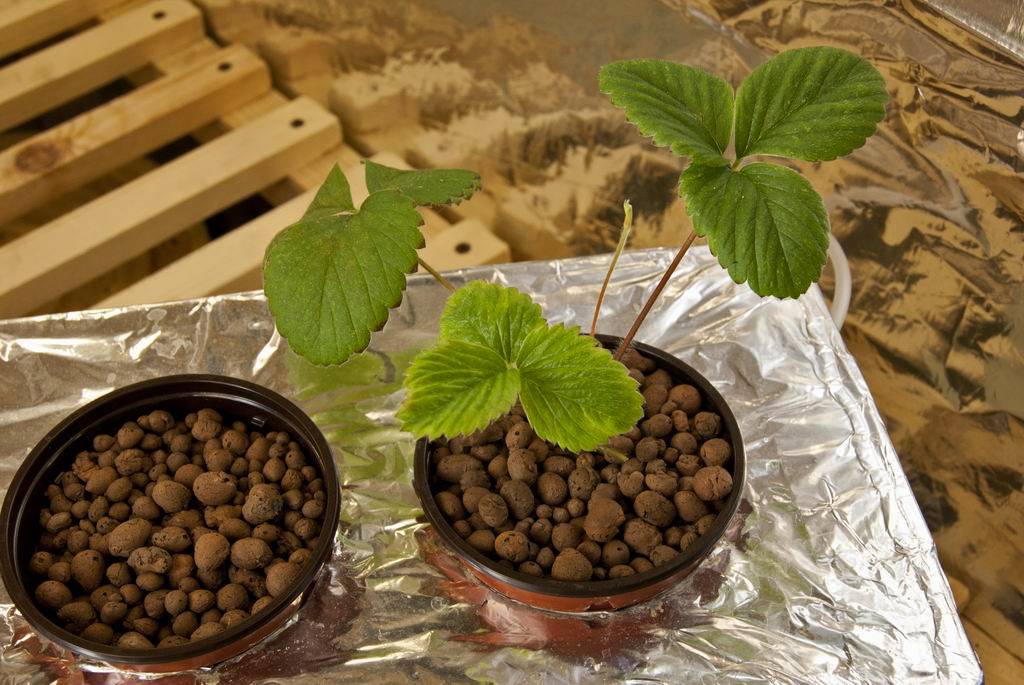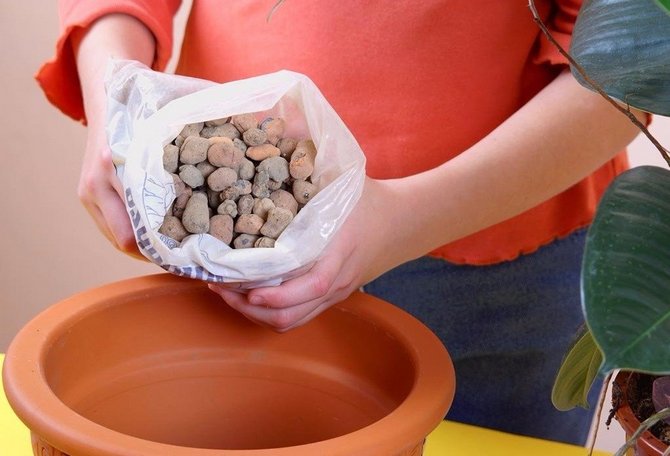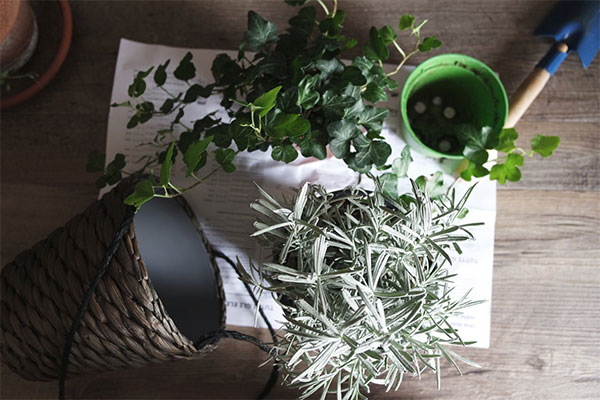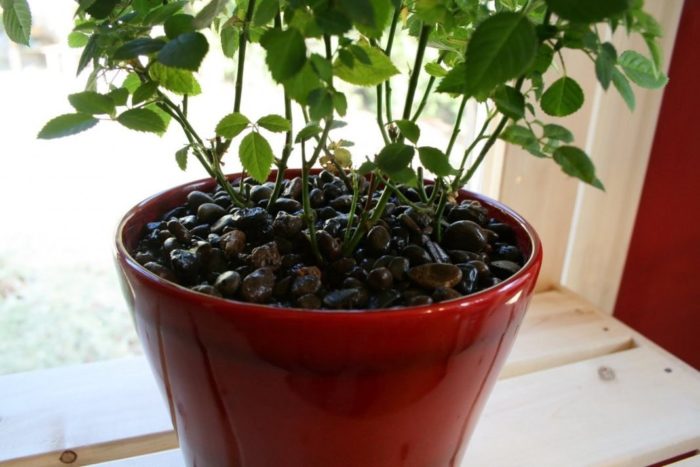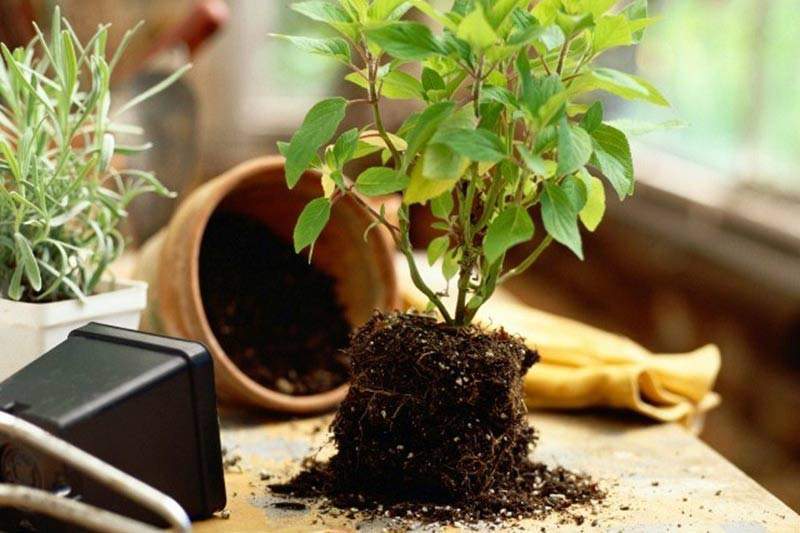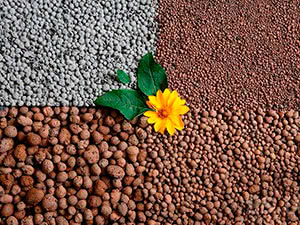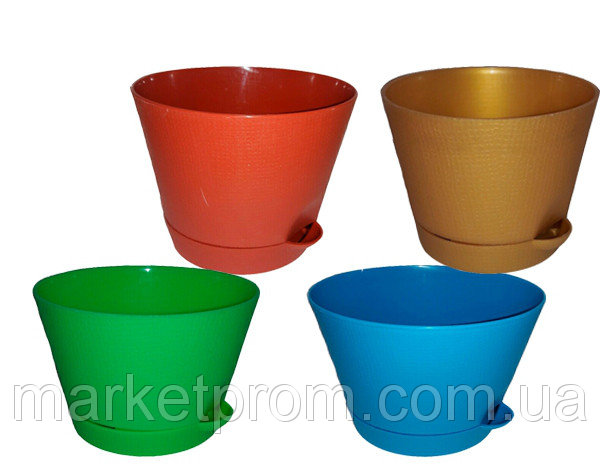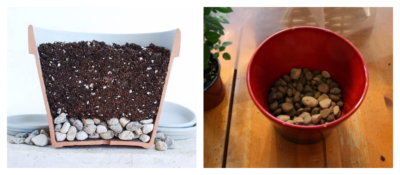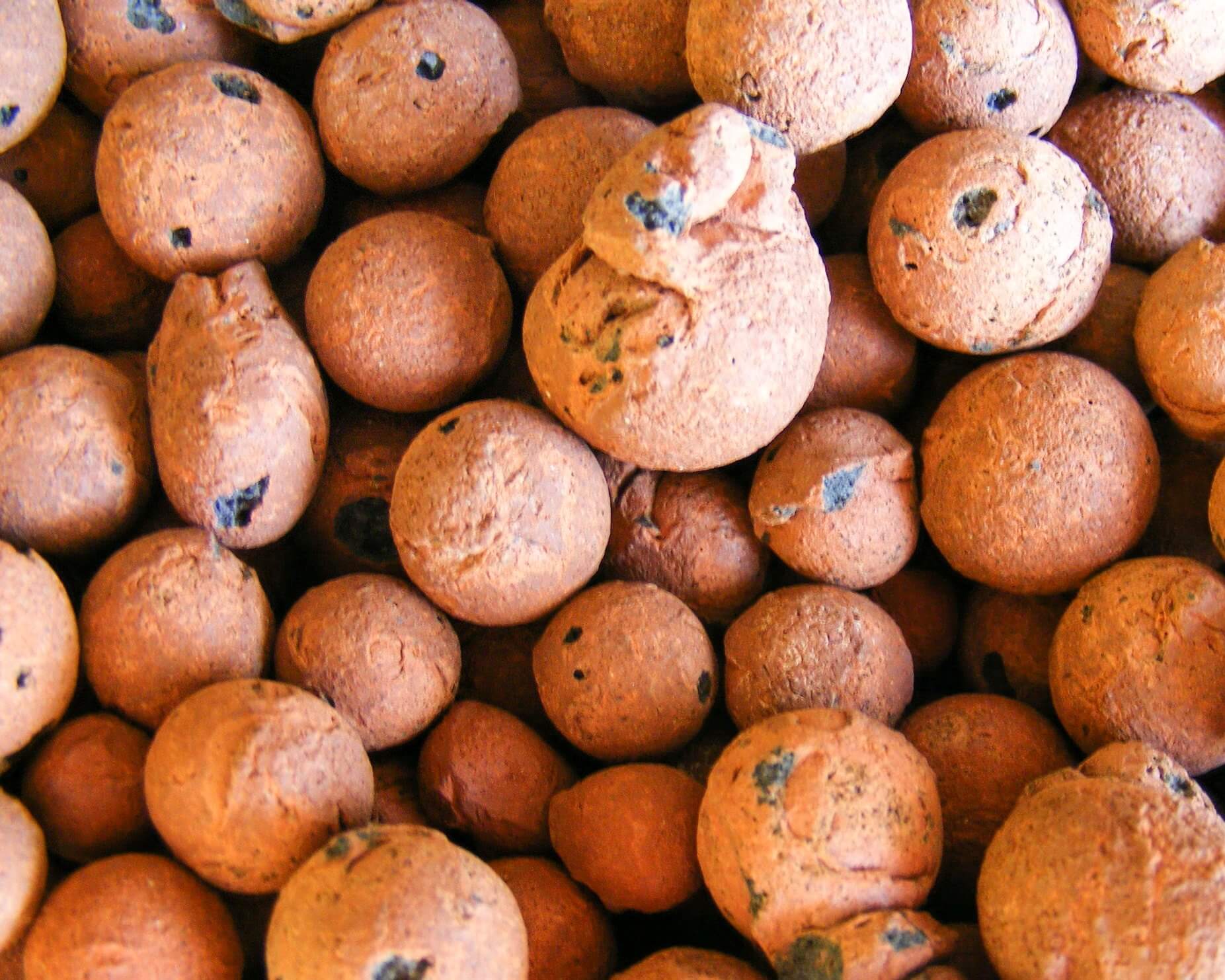Types of drainage systems
The type of drainage for flowers determines the material from which it is made. The products used for its device must pass water well, prevent the formation of mold and prevent the decay process. Depending on the material used, they are divided:
- Expanded clay. Expanded clay is one of the most common materials used for drainage. It is sold in the same stores as flowers, plants and other goods used by growers. Expanded clay is a building material that is used for insulation and sound insulation. It is sold in various sizes. Coarse fractions are used in large plant pots. It is not recommended to use small fractions, as they can get stuck in the drain holes. Therefore, mainly expanded clay of medium fractions is used, the grain size of which is up to 20 mm. For small pots with very small plants, quartz sand with a grain size of up to 5 mm is used. Expanded clay has the ability to absorb water and release it at the right time, not allowing the soil to dry out. Using this property, expanded clay can be impregnated with microelements useful for plants. After 5 years of service, expanded clay is destroyed and requires replacement.
- Ceramic. When draining pots, you can use pottery shards. Broken ceramic shards are placed on the bottom of the pot with the convex side up. All this is covered with sand, and then with earth, in which the planting is carried out. The fragments should not be very large, so that sand does not seep under them and does not clog the drainage holes.
- Gravel and crushed stone have good strength and other properties that are necessary for drainage layers. The disadvantages are heavy weight and inability to keep warm. Therefore, pots with such a drainage system should be placed on the south side.
- Styrofoam. Possesses such qualities as lightness and moisture resistance. Styrofoam is not subject to decay. When using polystyrene drainage, care must be taken to ensure that the roots do not grow into the foam, because they can be damaged during transplantation.
- Broken brick is also used by flower growers to decide how to make drainage. It has the same qualities as expanded clay, but before use it must be crushed to remove sharp corners that can damage the roots. For more information on flower drainage, see this video:
Drainage materials
Only materials of inorganic origin are suitable for creating the drainage layer. Moreover, they must be chemically neutral and have good resistance to degradation and oxidation. For example, marble chips are absolutely not suitable for drainage, since with prolonged interaction with water, it significantly reduces the acidity of the soil, making it unnecessarily alkaline. Fine-grained materials such as granulation or sand are also not particularly suitable as primary drainage. Over time, they solidify and clog drainage holes.
Expanded clay
It is for this material that the word "Drainage" has become a household word among amateur flower growers. It is under this name that it is sold. What is the difference between building expanded clay from drainage expanded clay, "flower"? Yes, actually nothing. In any case, from the point of view of the source material and manufacturing technology. In both cases, these are burnt lumps of clay. But there is still a difference. Firstly, it is washed before going on sale, cleaned of dirt and dust, and secondly, the drainage expanded clay is calibrated according to the size of the fraction.Therefore, on sale you can find expanded clay of small, medium and large fractions from 5 to 20 millimeters. It is selected based on the size of the flower pot and the diameter of the drainage holes. Balls - the granules must not block or spill through the holes.
There is a lot of controversy about the advisability of using expanded clay as a drainage material among professional flower growers. Despite its indisputable advantages, such as environmental friendliness, high hygroscopicity, lightness, one can also find counterarguments. The main one is to increase the acidity of the nutrient solution that the roots consume. One can agree with this statement, or one can argue with it. In any case, your humble servant has been using expanded clay as a drainage material for many years, and has not noticed any negative effect on the plants. Nevertheless:
Gravel, crushed stone, river pebbles
These materials are classified as "grass" and you can hardly buy them in the store. Therefore, their calibration and cleaning fall on the shoulders of the grower. At its core, this is also a pretty good drainage material. Its main advantage is durability. When using these materials, an additional layer of vermiculite or perlite must be poured over them. This will protect the roots of the plant from hypothermia and overheating.
Ceramic shards
When using shards of ceramics, we get a combination of the advantages of expanded clay and pebbles. Ceramics, despite the similarity of manufacturing technology and material, is more durable than expanded clay. At the same time, it is able not only to remove excess moisture from the roots of indoor flowers, but also to accumulate it, not allowing the earth to dry out completely.
Only clean, unglazed ceramics are suitable for use as drainage. Most tableware is not suitable for drainage.
At the same time, the use of clay shards must be very careful. They usually have sharp, jagged edges.
You must first blunt them. Otherwise, there is a high probability of root damage. To avoid such injuries, as well as for better moisture passage, clay shards should be laid with the convex side up, and sprinkled on top with a thin layer of fine expanded clay or vermiculite.
Broken brick
This material is most commonly used for growing succulents and potted plants without drainage holes. Only red bricks can be used. Its properties are similar to ceramics. Before creating a drainage layer from broken brick, it must also be prepared. Thoroughly remove dust and dirt, handle sharp edges.
Styrofoam
It is used as often as expanded clay. It is the cheapest and most readily available drainage material. Polyfoam is not able to absorb moisture and retain it, but it is quite suitable for removing excess water. Moreover, unlike bricks, pebbles and shards, polystyrene is much lighter, which means it does not weigh down the pot. In addition, it protects the roots of the plant from hypothermia on cold windowsills in winter. At the same time, its use should not be abused. It is perfect for plants with underdeveloped root systems or flowers that are replanted annually. Such as geranium, chlorophytum or hydrangea, if they winter in a pot, and in the summer they are planted in open ground. The fact is that plant roots are able not only to braid the pieces of foam, but to penetrate through them (like into a hydrogel). Then, at the next transplant, it will be impossible to remove them without damaging the roots.
What is drainage for indoor plants for?
The ideal balance of the components in which the indoor flower grows looks like this:
- 15% oxygen;
- 35% water;
- 50% solids.
The first two indicators provide drainage, removing excess moisture and allowing air to flow to the roots from the bottom of the pot.

Different materials on the bottom serve the same function
Drainage is a system that provides optimal moisture and respiration of the root system in the soil mixture. The system includes a drainage layer, moisture removal holes and auxiliary materials. The latter are mixed with the soil and allow you to retain moisture and provide the necessary conditions for the plants.
Interesting to know! The most ardent fans of drainage are succulents, especially cacti, representatives of the bromeliad family and orchids.
The layer is made of materials that:
- good water and air permeability;
- well disentangled from the roots during transplantation, and also do not damage the roots with sharp edges;
- do not enter into chemical bonds with the soil mixture;
- protected from rot and mold.
The average thickness of such a layer is 2-3 cm.It all depends on the requirements of the flower itself to the level of moisture in the soil.
It is also important which pot is the size and what holes are in it.

Soil quality does not affect the availability of drainage material
The functional purpose of the holes in the pot
The most direct purpose of a leaky bottom of a pot is to remove excess water. The stagnant fluid causes the roots to rot. Also, air passes through these holes to the roots and provides ventilation of the soil in the pot.
Bottom ventilation directly depends on the amount of soil mixture that needs to be drained. The type of green handsome man plays an important role. Epiphytes need ventilation not only at the bottom of the pot, but also along its walls.
The height of the layer of stones at the bottom of the pot is tied to its ability to pass water:
- One hole with a diameter of at least 1 cm in the bottom of the ceramic pot must be covered with a layer of at least 3 cm.
- The average number of small holes in the plastic pot is provided with 5 cm of drainage.
- If the bottom is wide, and there are many holes in it, a layer of 1 cm will be enough.
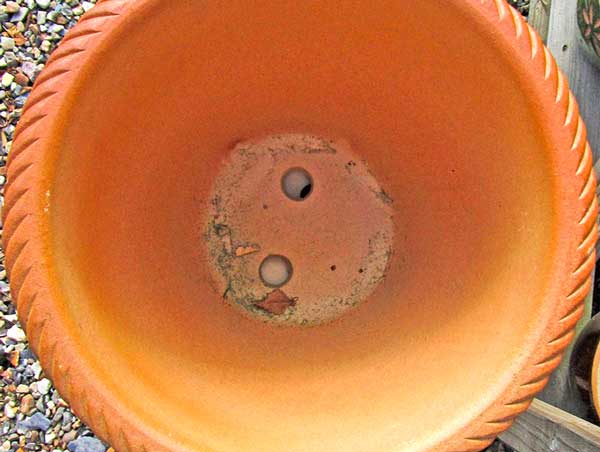
Drained bottom
Other elements and basic requirements
Soil drainage assistants include hydroabsorbents and mineral additives in the soil. They are able to retain moisture in the substrate, distributing it correctly. Keeps the soil moist and does not allow water to evaporate (important for the summer). They serve as soil orderlies, cleaning from harmful salts and toxins.
The drain pan is an auxiliary object for the liquid.
Important! It is necessary to drain all the water from the sump 30 minutes after watering. Such an environment will acquire fungi, mold and parasites.
The correct drainage device for domestic plants
Ultimately, the health and even the life of a green pet depends on how correctly the florist organized the drainage system.
With all the abundance of flower pots, one cannot fail to notice that the vast majority of them are plastic pots. Experienced growers even make additional drainage cuts in the side of the pot during transplanting this orchid. The ability of such plants to grow in swamps in their natural habitat does not mean that they can exist in the waterlogged soil of a flower pot. Consequently, there are fewer holes in the pot. But first of all, you must definitely familiarize yourself with the peculiarities of growing each specific type of indoor flower.
It is the cheapest and most readily available drainage material. Moreover, unlike bricks, pebbles and shards, polystyrene is much lighter, which means it does not weigh down the pot.
Both the upper deciduous part of the plants and the root system should be able to breathe.
This procedure is not limited only by the presence of holes, it is also necessary to use a special drainage material.

You need to put the pot on its side and clean them with a stick. Some plant species have such a developed root system that it fills the entire space of the pot. Through the drainage holes, the roots will be clearly visible, and you can easily trace their condition.

Only materials of inorganic origin are suitable for creating the drainage layer.For example, marble chips are absolutely not suitable for drainage, since with prolonged interaction with water, it significantly reduces the acidity of the soil, making it unnecessarily alkaline.
However, not everyone knows that the arrangement of a drainage layer in a bowl is not as simple as it seems at first glance. The drainage system also includes soil that has water and air permeable properties. That is why the correct drainage device is one of the most important stages in planting indoor flowers. It is safe to say that all indoor plants need drainage, however, the drainage system can be different.

You can buy a drainage mixture at a flower shop or at a building base, if, for example, you decide to buy crushed stone. After planting flowers, it is worth checking if the drainage system is working well.
Almost all novice flower growers believe that drainage is the same expanded clay that is sold in stores. The main one is to increase the acidity of the nutrient solution that the roots consume. One can agree with this statement, or one can argue with it. In any case, your humble servant has been using expanded clay as a drainage material for many years, and has not noticed any negative effect on the plants. Therefore, their calibration and cleaning fall on the shoulders of the grower. At its core, this is also a pretty good drainage material. Before creating a drainage layer from broken brick, it must also be prepared.
At the bottom of the pot, in the center of which a hole is made, the largest shard is laid. Then the main substrate is poured and the plant is planted. As a drainage for flowers, foam is excellent. Poinsettia from the milkweed family is an amazingly beautiful plant.
How can you endure such pain? And how much money have you already "poured" on ineffective treatment?

The use of organic materials for drainage is strictly prohibited - nuts or eggshells, tree bark. For more information, you can watch a video on how to drain houseplants with your own hands. It is forbidden to use such material as marble and granite chips as drainage, especially the first one.
Advantages and disadvantages of various types
We recommend that you familiarize yourself
Classic expanded clay can be used as drainage. Its granules are most often rounded. Sometimes there is also expanded clay crushed stone, which has sharp edges and corners. The main advantage of this material is its light weight and affordability. Expanded clay can be purchased both in the departments for flower growers and summer residents, and in hardware stores. It is necessary to replace such a layer once every 4-5 years, since the material collapses over time. Instead of expanded clay, you can use broken ceramic dishes. The main thing is that its particles are not very small or too large. But he also has disadvantages. Unlike expanded clay, ceramic drainage is not as easy. In the pores of clay shards, mold can grow over time, therefore, when transplanting plants, such a layer must be disinfected by washing the pieces of ceramics in a solution of potassium permanganate.
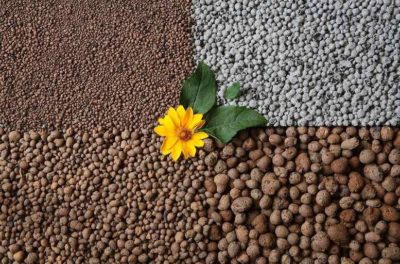
Broken brick is another option for an inexpensive and effective drainage layer. You just need to go outside and walk to the nearest construction site. The brick must be folded into 2 dense bags, carefully walk over the roll with a hammer and select the parts necessary by size. Before you put the elements in the pot, they must also be rinsed well in potassium permanganate. The disadvantages and advantages of the material are the same as those of the clay shards.
Do you want the weight of the flower pot to be less? It is worth paying attention to the usual foam. It is very lightweight and does not absorb water at all
Divide a piece of styrofoam into pieces up to 2 cm in size and place on the bottom of the pot. The advantages of the material include the fact that it protects plant roots from both strong cooling and overheating.The disadvantages of styrofoam include the fact that the roots of domestic plants grow very quickly through its granules. The solution is simple - during transplantation, the material can be easily broken. Another disadvantage noted by the owners of home plants is that a green bloom easily appears on the pieces of foam. But this is just a layer of algae, and it does not harm indoor flowers in any way.
Even a synthetic winterizer can serve as a drainage layer. It is a modern material that is used as insulation for jackets. You can find it in any sewing store. It perfectly permeates water and air and does not deteriorate from moisture. Just cut the synthetic winterizer into pieces and place it on the bottom of the pot. Or you can cut several circles to fit the bottom and stack them on top of each other. The main advantage of this material is its lightness. Artificial material does not rot, does not decompose or deteriorate over time. Of the shortcomings, only the inconvenience of reuse can be noted. Therefore, it is easier to cut a new synthetic winterizer than to lay the old one.
But coarse river sand as drainage is completely unacceptable. It quickly clogs the drainage holes in the pot, and the earth begins to turn sour and green on the surface. It is also not recommended to use marble or granite as a basis for drainage, more precisely, chips from them. The salts in these minerals make the soil alkaline, which adversely affects the plants.
How to replace drainage for flowers
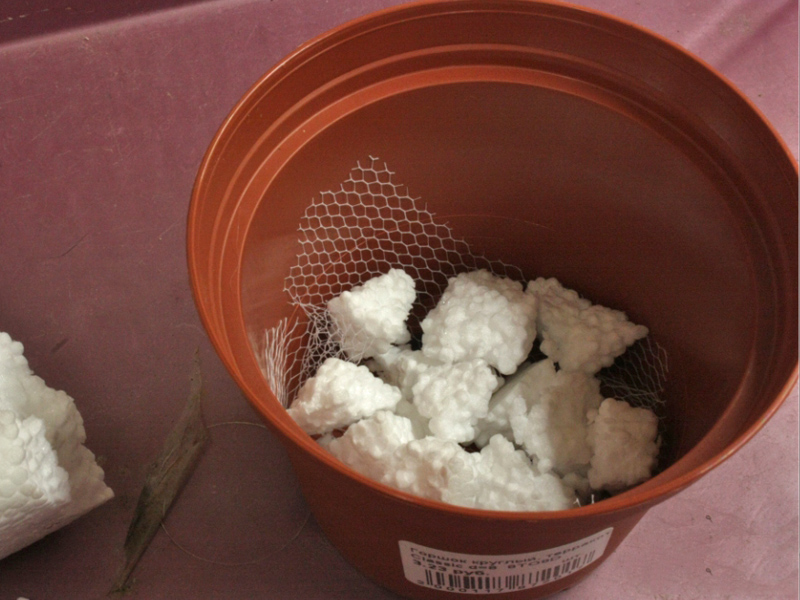
Special drainage for home flowers can be replaced with something that has similar properties. In this case, you do not need to buy it, it is enough to go out into the yard or rummage in the pantry. Examples of a drainage system made from scrap materials:
- Brick. Before use, it is split into small pieces and calcined in a pan or oven. For the construction of drainage, silicate brick is more suitable, since it is able to absorb water, which subsequently gives to the plant when the soil dries. The downside is the presence of sharp edges that can harm the roots.
- Gravel and crushed stone. Due to their large size, the use of these materials is advisable for creating a drainage layer in the garden. For indoor flowers, stones only of a small fraction are suitable. Before being placed in a pot, they are also calcined to destroy harmful microorganisms. Minus - the stones are very massive, so they significantly make the flower pot heavier.
- Styrofoam. It is a cheap porous material that can be used in place of moss. Before use, it must be broken into small pieces and disinfected with a dark solution of potassium permanganate. It has no special advantages. Minus - germination of roots through the foam.
- Cork. If you haven't thrown away the wine corks, they can be cut into cubes and used as drainage. By their properties, they resemble polystyrene, but it is more difficult for the roots to break through the cork.
The improvised substitutes for drainage materials do a good job with their functions. Although they have more negative sides than special ones. But this does not prevent flower growers from using them for various plants.
Other elements and basic requirements
What material is used if the necessary elements are not at hand? If you cannot find any of the above-mentioned materials - do not be discouraged, there will always be a way out. Use what is at your fingertips. So what can replace drainage?
- Crushed stone and gravel. Drainage from these stones perfectly replaces the traditional one. The only drawback is that these elements make the pot much heavier. So if you take a small pot or one that you will not often rearrange from place to place, such material will do just fine.
- Aquarium stone. Such stones are a good alternative, but the price is quite high. But if you have this material, why not use it?
- Styrofoam. Polyfoam perfectly replaces the usual elements.It meets the required requirements and can be found almost everywhere. People tend to store boxes from under appliances or household appliances, so there is no better budget drainage option. True, it is not crumbled into a pot, but cut into cubes and laid in a layer of several centimeters. Of course, damage to the root system can be a significant disadvantage if the roots of the plant are entwined with foam.
- Brick. You can also replace traditional materials with broken bricks. It is a natural material with the required properties. However, before you lay it on the bottom of the pot, sharpen the edges, otherwise the roots of the plant may be damaged. White brick works better than red brick.
We also mentioned the basic requirements earlier. Care must be taken to ensure that the drainage has the necessary properties and does not harm the plant. This will be enough to achieve the desired result.
Preparing for transplanting indoor flowers
Before proceeding with a flower transplant and filling the drainage, you need to make sure that the materials used are clean. The drainage must be filled up before planting, it must not be wet and if it has been used before, it must be thoroughly washed and disinfected.
The containers for planting should be pre-cleaned and dried, the recommendations for the store substrate should be checked: many types of materials should be moistened. In this case, the drainage should be placed in treated purified water.
By watching the video, you will learn about drainage.
Drainage is a system that maintains the required moisture content of the substrate for the vegetation grown at home. Using drainage is a very important process for planting and replanting plants.
For the most comfortable plant development, experienced gardeners recommend creating a favorable atmosphere for the flower. External factors affecting the growth and development of a flower can be considered sunlight, air humidity, ambient temperature and drainage system. And this is quite an important point, because properly selected drainage can significantly affect both the flower itself and the mistakes in care. Read about how to drain the site.
Drainage for flowers - what is it?
Flower drainage is a system that allows excess moisture to be removed through the flower's root system and soil layer. A plant is a living organism, therefore, it needs to breathe. All parts of the plant need access to oxygen:
- Leaves;
- Root system;
If the grower floods the flower with water for any reason, it will literally displace all oxygen bubbles from the soil layer. The anaerobic environment promotes the development of various kinds of bacteria. An airless environment leads to rotting of the root system, the flower withers as a result.
The essence of the "work" of the drainage system is to remove excess moisture from the plant and allow the root system to breathe without problems. Read on and how to seat him.
Therefore, each flower needs:
- Have at least one small drainage hole at the base of the flowerpot. It is necessary so that excess water comes out through it, plus this hole makes it possible to circulate air.
- At the very bottom of the pot, it is necessary to lay out a layer of 2-5 cm (depending on the type of plant) drainage.
Drainage for flowers, photo varieties
Today, you can not only buy drainage for a plant in a flower shop, but also make it yourself.
There are different types of drainage for flowers:
- expanded clay drainage for flowers, the most sold and popular type of drainage. Only some types of fractions (fine and medium) are used for drainage;
- Styrofoam as a drainage agent for flowers is the most readily available substance ever used to create a drainage system.It is not affected by mold, is moisture resistant, chemically inert and does not decompose;

drainage based on pieces of tiles or ceramic, only a few pieces of earthenware are needed for drainage;
drainage from crushed stone and gravel, it is often used in garden plots, such a drainage system will last for many years;

drainage from sphagnum moss. Best drainage option for indoor plants. Capable of retaining moisture, disinfectant;

charcoal drainage. Possesses good antiseptic properties, can be used as fertilizer;
broken brick drainage. Not the best drainage option. Sharp corners can damage the plant's root system;

Vermiculite drainage perfectly absorbs liquid fertilizers and water. It can serve as a top dressing months after it has been carried out.

at the place of application:
- drainage for indoor flowers;
- drainage for garden plants;
How to make drainage for flowers in the garden?
In order to create a drainage system on a personal plot, you must:
- choose the material from which the drainage will be performed;
- prepare the second layer (most often sand is used for the second layer);
- and also "get hold of" a soil-soil mixture;
After all the necessary elements are collected to create drainage, it will be necessary:


